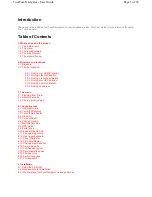
9.
Connect the device’s red VDC power wire to the trailer’s blue “aux” wire/center pin on the 7-way
trailer wire stud using a heat shrink ring terminal poke-and-wrap method. Alternatively, the marker or
running lights wire can be used instead of the aux wire. Shown below are the typical wiring colors and
pin layout for a tractor-trailer 7-way
connector.
10. Coat both newly installed ring terminal connections with dielectric grease or terminal protecting anti
corrosion spray as necessary, and use a wire loom to protect any remaining exposed wiring portions
not protected by the device’s wire harness jacket.
11. Remount the 7-pin cover plate.
3-Wire Installation Steps
1. Connect th
e device’s
Red VDC
power
wire to the asset’s +12/24 VDC constant battery power
source.
2.
Connect the device’s
Black Ground
wire to the asset's negative battery terminal. If that is not
practical, connect instead to a chassis ground on the asset by using a ring terminal and self-tapping
screw or factory bolt.
3.
Connect the device’s white Ignition wire to the asset’s +12/24 VDC ignition/switched power. The
asset’s ignition source will vary depending on the type of asset; it could be located at the asset’s
ignit
ion switch or at the asset’s fuse box.
4. Coil up and zip tie any extra length of the device harness.
Do not cut the harness
to shorten it, as
doing so limits the device’s usability if transferred to another asset in the future and also increases the
chance of making an error with wiring.
3-Wire Installation for Reefer Trailers
While most trailers require 2-wire installation, Reefer trailers are an exception, usually requiring 3-wire
installation. In addition to the primary three wires, a digital input wire should be used to enable monitoring
the reefer’s engine hours via the reefer’s ignition circuit.
Connecting to digital input/output sensors
After installing the primary device wiring, you can proceed to the I/O wiring for sensors, if called for in the
work order. Sensor functions such as PTO, boom, rear door, or lights are an optional part of the
installation. If installation does not include I/O wiring, disregard this section and proceed to completing the
installation as instructed in the Reveal Hardware Installer app.



































